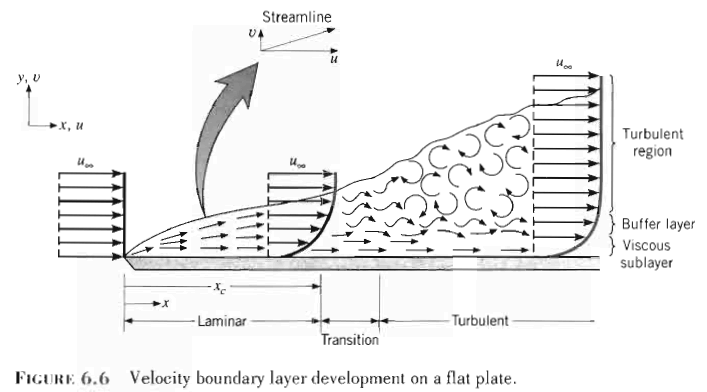Boundary Layer Thickness
Laminar and Turbulent Boundary Layers
A boundary layer may be laminar or turbulent. A laminar boundary layer is one where the flow takes place in layers, i.e., each layer slides past the adjacent layers. This is in contrast to Turbulent Boundary Layers shown in Fig.1 where there is an intense agitation.
Read Also : Laminar Flow vs Turbulent Flow
In a laminar boundary layer any exchange of mass or momentum takes place only between adjacent layers on a microscopic scale which is not visible to the eye. Consequently molecular viscosity
A turbulent boundary layer on the other hand is marked by mixing across several layers of it. The mixing is now on a macroscopic scale. Packets of fluid may be seen moving across. Thus there is an exchange of mass, momentum and energy on a much bigger scale compared to a laminar boundary layer. A turbulent boundary layer forms only at larger Reynolds numbers. The scale of mixing cannot be handled by molecular viscosity alone. Those calculating turbulent flow rely on what is called Turbulence Viscosity or Eddy Viscosity, which has no exact expression. It has to be modelled. Several models have been developed for the purpose.
As a consequence of intense mixing a turbulent boundary layer has a steep gradient of velocity at the wall and therefore a large shear stress. In addition heat transfer rates are also high. Typical laminar and turbulent boundary layer profiles are shown in fig 2. Typical velocity profiles for laminar and turbulent boundary layers Growth Rate (the rate at which the boundary layer thickness
where Rex is the Reynolds Number based on the length of the plate. For a turbulent flow it is given by
Wall shear stress is another parameter of interest in boundary layers. It is usually expressed as Skin friction defined as
where
and
Skin friction for laminar and turbulent flows are given by
Read Also :
Venturi Flow Meter
Pitot Tube
Coriolis Mass Flow Meter
Electromagnetic Flow Meters
Hydraulic Diameter
Boundary Layer Thickness
We defined the thickness of the boundary layer as the distance from the wall to the point where the velocity is 99% of the “free stream” velocity. For laminar boundary layers over a flat plate, the Blasius solution of the flow governing equations gives:
where Rex is the Reynolds number based on the length of the plate.
For a turbulent flow the boundary layer thickness is given by:
This equation was derived with several assumptions. The turbulent boundary layer thickness formula assumes that the flow is turbulent right from the start of the boundary layer.
Displacement Thickness
It is not exactly true that the boundary layer does not affect the potential flow at all. The potential flow streamlines just above the boundary layer will be slightly displaced away from the wall by the boundary layer:
Suppose a potential flow streamline in the matching region would be at a distance h from the wall if there was no boundary layer, then it has streamfunction value
The displacement of the streamline follows:
Since the integrand disappears above the boundary layer, this displacement is the same for all streamlines in the matching region. Assuming we use the boundary layer solution for the velocity profile, we may as well write
The result of this displacement is that as far as the potential flow is concerned, the body is thicker by an amount
From the solution of the Blasius profile, it follows that for a flat plate in a uniform flow,
Example: Boundary Layer Thickness
Consider a water flow (20°C) at v = 0.1 m/s past a flat plate 1 m long. Compute the boundary layer thickness in the middle of the plate. Assume that kinematic viscosity of water at 20°C is equal to 1×10-6 m2/s.
The Reynolds number for the middle of the plate is equal to:
ReL/2 = 0.1 [m/s] x 0.5 [m] / 1×10-6 [m2/s] = 50 000
This satisfies the laminar conditions. The boundary layer thickness is therefore equal to:
δ ≈ 5.0 x 0.5 / (50 000)½ = 0.011 m
Source Article : Nuclear Power ; http://www-mdp.eng.cam.ac.uk ; ww2.eng.famu.fsu.edu/
Image Source : Nuclear Power

